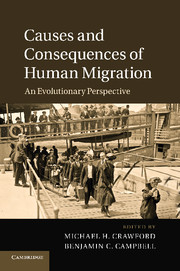Book contents
- Frontmatter
- Contents
- Contributors
- Preface
- 1 Perspectives on human migration: introduction
- Section 1 Theory
- Section 2 Geography and migration
- 8 Population structure and migration in Africa: correlations between archaeological, linguistic, and genetic data
- 9 Human migrations in North Africa
- 10 Identity, voice, community: new African immigrants to Kansas
- 11 The African colonial migration into Mexico: history and biological consequences
- 12 Demic expansion or cultural diffusion: migration and Basque origins
- 13 Consequences of migration among the Roma: immunoglobulin markers as a tool in investigating population relationships
- 14 Migration, assimilation, and admixture: genes of a Scot?
- 15 Mennonite migrations: genetic and demographic consequences
- 16 Human migratory history: through the looking-glass of genetic geography of Mycobacterium tuberculosis
- 17 Peopling the Tibetan plateau: migrants, genes, and genetic adaptations
- 18 Migration, globalization, instability, and Chinese in Peru
- 19 The great blue highway: human migration in the Pacific
- 20 Migration of pre-Hispanic and contemporary human Mexican populations
- 21 A review of the Tupi expansion in the Amazon
- 22 Molecular consequences of migration and urbanization in Peruvian Amazonia
- 23 Migration in Afro-Brazilian rural communities: crossing historical, demographic, and genetic data
- 24 Indentured migration, gene flow, and the formation of the Indo-Costa Rican population
- 25 Causes and consequences of migration to the Caribbean Islands and Central America: an evolutionary success story
- Section 3 Overview
- Index
- References
22 - Molecular consequences of migration and urbanization in Peruvian Amazonia
Published online by Cambridge University Press: 05 December 2012
- Frontmatter
- Contents
- Contributors
- Preface
- 1 Perspectives on human migration: introduction
- Section 1 Theory
- Section 2 Geography and migration
- 8 Population structure and migration in Africa: correlations between archaeological, linguistic, and genetic data
- 9 Human migrations in North Africa
- 10 Identity, voice, community: new African immigrants to Kansas
- 11 The African colonial migration into Mexico: history and biological consequences
- 12 Demic expansion or cultural diffusion: migration and Basque origins
- 13 Consequences of migration among the Roma: immunoglobulin markers as a tool in investigating population relationships
- 14 Migration, assimilation, and admixture: genes of a Scot?
- 15 Mennonite migrations: genetic and demographic consequences
- 16 Human migratory history: through the looking-glass of genetic geography of Mycobacterium tuberculosis
- 17 Peopling the Tibetan plateau: migrants, genes, and genetic adaptations
- 18 Migration, globalization, instability, and Chinese in Peru
- 19 The great blue highway: human migration in the Pacific
- 20 Migration of pre-Hispanic and contemporary human Mexican populations
- 21 A review of the Tupi expansion in the Amazon
- 22 Molecular consequences of migration and urbanization in Peruvian Amazonia
- 23 Migration in Afro-Brazilian rural communities: crossing historical, demographic, and genetic data
- 24 Indentured migration, gene flow, and the formation of the Indo-Costa Rican population
- 25 Causes and consequences of migration to the Caribbean Islands and Central America: an evolutionary success story
- Section 3 Overview
- Index
- References
Summary
Introduction
With its rich archaeological and historical record, Peru offers an exceptional opportunity for the study of human migration. While Amazonia comprises nearly 60% of the country’s national territory, most studies of Peru’s human populations have emphasized the Andean highlands. The selva baja, or lowland tropical forested region of Peru’s Lower Huallaga Valley, is particularly important for genetic studies on migration. A geographically significant crossroads of migration, the Lower Huallaga Valley is characterized by its degree of ethnic diversity among both indigenous and immigrant populations. Despite centuries of colonization, many contemporary indigenous societies reside in the selva baja region surrounding the city of Yurimaguas, including: Quechua-speaking populations (Kichwa Lamista, Kichwa del Pastaza); Jibaroan speakers (Achuar, Awajun, Kandozi, Wampis, and Jibaro); Tupi-Guarani speakers (Kukama-Kukamira); Cahuapanan speakers (Shawi and Shiwilu); Arawakan speakers (Chamicuro); and the Urarina (linguistic isolate).
In light of the region’s recent pattern of urbanization, this study evaluates the genetic consequences of migration using mitochondrial DNA (mtDNA) to characterize the maternal genetic structure of residents of the “new urban settlements” (or barriadas) enveloping Yurimaguas, one of the selva baja’s principal cities (Dean and Silverstein, 2011). Maternal markers were used to infer prominent source population and/or pattern of migration into the provincial capital city of Yurimaguas by comparing the focus sample with others from South America. By estimating the proportion of non-native maternal admixture and establishing estimates of a past population reduction we provide novel insights for understanding the effects of human migration in the Lower Huallaga Valley.
- Type
- Chapter
- Information
- Causes and Consequences of Human MigrationAn Evolutionary Perspective, pp. 449 - 472Publisher: Cambridge University PressPrint publication year: 2012
References
- 3
- Cited by

